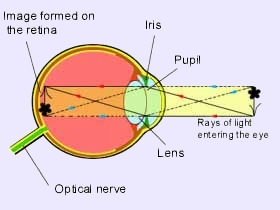Visual Perception
Vision is our dominant sense - we gain most of our experiential information through the process of seeing (Wade & Swanston, 1991; Gregory, 1970). Visual perception is seen as both a physiological and psychological process, a topic of empirical study and theorizing. One of the most current models to describe visual perception is information processing, borrowed from the discipline of computer science (Haber, 1969; Wade & Swanston, 1991). In fact, much of the work done on brain and vision research has been compared to mechanical processes.
In the past, the brain has been compared to clockwork contraptions, pneumatic or hydraulic devices, power and force, telephone exchanges and now, computer systems. Such metaphors were useful in their time yet obviously gave an incomplete picture of the true nature of brain and visual function (Gregory, 1970). Even now, the comparison to a computer system is naively incomplete.
We are just beginning to understand the very organs that provide us with the major part of our perceptual input and awareness. What we do know is that humans as a whole, share the same fundamental physical structure that governs the process of seeing.
"There is a basic, perceptual visual system, one that all human beings have in common; but the system is subject to variations, variations on basic structural themes. There is visual syntax and its dominant characteristic is complexity." (Dondis, 1973, p. 12).
Perceptual experience is fundamentally subjective. Humans are able to reflect upon and share their experience with others, and are quite often rewarded with similar experiential reports from those they share theirs with. This characteristic of visual perception has been an important subject in the discipline of philosophy since classic times. Psychology too has offered several theories about visual perception ranging from Wundt's passive structuralist views of analytic introspection to Gestalt theories of active innately organized perception (Wade & Swanston, 1991).

Modern theorists agree that the process of visual perception begins with the stimulus of light that affects the eye, our visual sensory organ and elicits a response to the light energy. Visual optics theory explains how light rays enter the cornea of the eye
which refracts and funnels the ray onto the inner back of the eye, causing a retinal stimulus and image response (Armstrong, 1991). All of the anatomical parts of the eye from the lens to the ligaments play a refined and intricate part in the process of seeing. This is common to all humans with healthy functioning eyes. Biology has provided an understanding of the visual cortex, the most well known part of the cerebral cortex of the brain (Hubel, 1995). Yet, the actual interpretation of what is perceived can be truly unique and subjective. (Wade & Swanston, 1991).
"We tend to assume that when viewing a scene every observer has the same perception. Since most of the time no conflict arises between observers, this does not seem a bad assumption" (Davidoff, 1975). Still, people vary on the way they process visual information into perceptual experiences, perceptual memories and perceptual responses (Haber, 1969). Coltheart (1999) pointed out that humans believe they perceive the entire visual field of a scene clearly. "This, however, is an illusion: we see in detail only information that falls on the fovea. This is an area about 1 mm square on the retina that is very densely packed with photoreceptive cells, the cones" (p. 3). Our perceptual experiences are coloured by heredity, socialisation, individual awareness and culture.
References
Chandler, S. (2001). Living and learning ideas II. http://www.msu.edu/~dwong/CEP900/LL2/SherriLL2.htm
Phillips, D. and Soltis, P. (1998). Perspectives on Learning. New York, N.Y.: Teachers College Press.
Smagorinsky, P. (n.d) The social construction of data: Methodological problems of investigating learning in the zone of proximal development. http://psych.hanover.edu/vygotsky/smagor.html
Vygotsky, L. S. (1981). The instrumental method in psychology. In The concept of activity in Soviet psychology. ed. J. V. Wertsch. Armonk, N.Y.: M.E. Sharpe.
Wertsch, J. V. (1991). Voices of the mind: A sociocultural approach to mediated action. Cambridge, MA: Harvard University Press.
nursing-informatics.com - an initiative by:
June Kaminski, MSN PhD(c) © 2000 - 2023
|
 |
|

